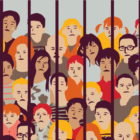
When students bring guns to North Carolina schools
|
West Charlotte High School had let out only minutes earlier when, hearing gunfire, school officials ordered an immediate lockdown and Charlotte-Mecklenburg Police Department officers swarmed the campus. That incident, the week before Christmas break 2021, was the ninth time a gun had been found at one of Charlotte-Mecklenburg’s most troubled public schools since the start of the school year.








